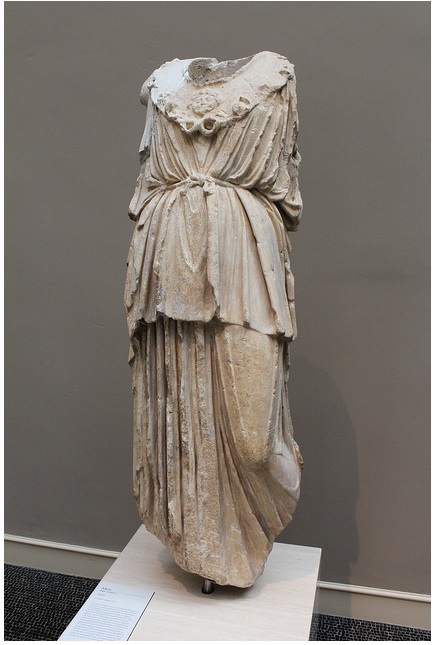
Unknown
Roman
Athena, 5th c. BCE late
marble
51 1/2 × 17 × 14 5/8 in.
SBMA, Gift of Wright S. Ludington
1978.4.3

Detail of the Gorgons head
COMMENTS
Roman copy (Augustan?) of Athena (Ince Hall type)
Statues of Athena are probably among the types most familiar to museum visitors with some knowledge of classical antiquity. The Santa Barbara Athena, though many times removed from the colossal cult statue of Athena that once stood in the Parthenon and was there viewed and described by Pausanias and other writers of antiquity, nonetheless reflects the famed Pheidian original. Its immediate prototype was more likely a marble statue modeled after the gold and ivory statue by Pheidias sometime in the last decades of the fifth century BCE.
A number of headless Athenas, stylistically parallel to the Santa Barbara Athena, have deep sockets that suggest that they, and others of the same sort, may have been designed so that their heads were attached separately.' The Santa Barbara Athena, however, clearly shows traces of hair at the back of the neck, just left of center, as if the head were turned slightly to the right - evidence indicating that the statue, like the SBMA Peplophoros was carved all in one piece and that the socket was carved out after the head was broken off, to hold the repaired head or a new head. Further support for this theory may be found in an Athena that so resembles the Santa Barbara Athena that it may almost be taken as a mate. This is the example known as the Ince Hall Athena found in the nineteenth century at Ostia and now in Ince Blundell Hall in England. Although some restorations mar this fine piece, there is no doubt that both head and body were carved from a single piece of white marble. Even though large parts of the Santa Barbara Athena are missing, the pose of the goddess can be reconstructed. She stands frontally with the weight on her right leg. The left leg is noticeably bent, and the angle of the folds of the lower part of the peplos shows that the left foot, now missing, must have been poised far to the left at an outward angle from the body. One must overlook the small piece of the right arm and deltoid, part of the modern restoration in a different stone (probably done on the assumption that this was an Athena of the type in which the right arm is upraised holding a spear),' and look at the original modeling at the front and back areas of the restored right shoulder. This suggests that the Santa Barbara Athena held her right arm, as well as her left arm, downward in a pose similar to that of the Ince Hall Athena (though the lower half of that Athena's arm is also a restoration). The Santa Barbara sculpture, like most Athenas of the Ince Hall type, wears the peplos. The overfold (apoptygma) reaches to about mid-thigh, and a pouchlike kolpos is formed at each hip by the tight belting. The aegis with its gorgoneion (Medusa head) is also a traditional ornament in Athenas of this type, although it appears in many variations. Here it is rather narrow. This, too, is strikingly similar to the Ince Hall Athena. The differences in the patterns of folds in the drapery of the two Athenas are decidedly minor and in no way diminish the possibility that the two statues may have come from the same workshop. It is tempting to see in the Santa Barbara Athena something of Myron's portrayal of the goddess in his Athena-Marsyas group, which stood on the Acropolis. In that case the prototype could be not the Athena Parthenos but an earlier one of the 5th century attributed to Alkamenes, a contemporary of Pheidias. The weight of the evidence, however, remains with Ashmole’s proposal that the Ince Hall Athena--and therefore the SBMA Athena--is a Roman copy based on a late 5th century original inspired by the earlier Athena Parthenos by Pheidias.
- Adapted from Mario A. Del Chiaro, Classical Art Sculpture, SBMA catalog, 1984, pp. 21-23
